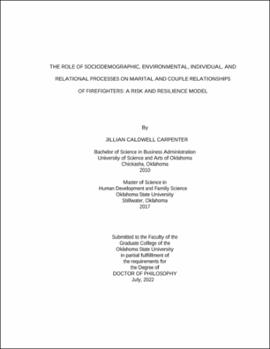| dc.contributor.advisor | Hendrix, Charles | |
| dc.contributor.author | Caldwell Carpenter, Jillian | |
| dc.date.accessioned | 2023-04-05T16:20:45Z | |
| dc.date.available | 2023-04-05T16:20:45Z | |
| dc.date.issued | 2022-07 | |
| dc.identifier.uri | https://hdl.handle.net/11244/337264 | |
| dc.description.abstract | Firefighters experience chronic stress and potentially-traumatic events as part of their occupation. Exposure to chronic or acute stress can have harmful outcomes on firefighters and their families. The overall goal of this study was to develop and test a mid-range model of risk and resilience for marital and couple relationships of firefighters. This goal included 1) constructing a theoretical model based in theory and previous empirical research, 2) assessing reliability of the instruments used to measure the theoretical constructs, and 3) testing the theoretical model in a sample of 169 firefighters in the United States. Using the family resilience model (FRM; Henry et al., 2015) to construct the theoretical model, two adaptation outcomes and seven concepts were identified as potentially-important in risk and resilience processes of firefighter couple relationships. The two adaptation outcomes identified were relationship quality and relationship satisfaction. The potentially-important concepts include occupational stress, traumatic exposure, perceived stress, posttraumatic stress disorder symptomatology, individual firefighter coping, couple functioning, and dyadic coping. Confirmatory factor analysis was used to assess reliability of the measures. Path analysis was used to test the theoretical model using a model building approach. Findings of reliability assessments indicate appropriate use of measures in this population with special considerations. Results of path analysis failed to support the overall theoretical model but provided evidence for the importance of constructs and certain relationships. Results suggest occupational stress and perceived stress function as risk and vulnerability. Planning coping, reframing coping, and humor coping may function as protection, enhancing the potential for positive adaptation to risk. Healthy couple functioning and dyadic coping may also function as protection by predicting higher relationship quality and satisfaction. Overall, findings indicate risk and resilience processes in marital and couple relationships of firefighters are complex and nuanced. | |
| dc.format | application/pdf | |
| dc.language | en_US | |
| dc.rights | Copyright is held by the author who has granted the Oklahoma State University Library the non-exclusive right to share this material in its institutional repository. Contact Digital Library Services at lib-dls@okstate.edu or 405-744-9161 for the permission policy on the use, reproduction or distribution of this material. | |
| dc.title | Role of sociodemographic, environmental, individual, and relational processes on marital and couple relationships of firefighters: A risk and resilience model | |
| dc.contributor.committeeMember | Washburn, Isaac | |
| dc.contributor.committeeMember | Henry, Carolyn | |
| dc.contributor.committeeMember | Neal, David | |
| dc.contributor.committeeMember | Mwavita, Mwarumba | |
| osu.filename | CaldwellCarpenter_okstate_0664D_17785.pdf | |
| osu.accesstype | Open Access | |
| dc.type.genre | Dissertation | |
| dc.type.material | Text | |
| dc.subject.keywords | firefighters | |
| dc.subject.keywords | marital and couple relationships | |
| dc.subject.keywords | relationship quality | |
| dc.subject.keywords | relationship satisfaction | |
| dc.subject.keywords | risk and resilience | |
| dc.subject.keywords | stress | |
| thesis.degree.discipline | Human Development and Family Science | |
| thesis.degree.grantor | Oklahoma State University | |
